Influential AAPI Fashion Designers: Past Pioneers to Present Innovators
Written by Katrina Oro
Through their designs and creative vision, Asian American Pacific Islander (AAPI) designers have woven their talent into the fabric of the fashion industry. AAPI Heritage month allows us to celebrate the diversity of their cultures and their contributions to a constantly evolving industry. From challenging traditional design norms to shaping the future of fashion, AAPI designers continue to leave a long-lasting impact on society.
Early designers like Issey Miyake, Josie Natori, and Yeohlee Teng, became some of the first Asian Americans to break through in an industry dominated by European and American brands such as Dior, Ralph Lauren, and Marc Jacobs. Their success in the world of fashion helped to represent AAPI individuals and pave the way for them for more opportunities in the future.
Since then, more AAPI designers have joined the industry and offer their own unique aesthetic, including Hanako Maeda, Sandy Liang, and Hung La. Through their designs and purposeful inclusion of AAPI models these designers brought the visual identity to the industry. Because of their initial experiences with a lack of representation in the industry, AAPI designers are motivated to broaden their representation of cultures, to inspire others, and bring something new to fashion. In honor of Asian American and Pacific Islander Heritage Month, we recognize early influential AAPI designers and current designers for whom the path has been paved.
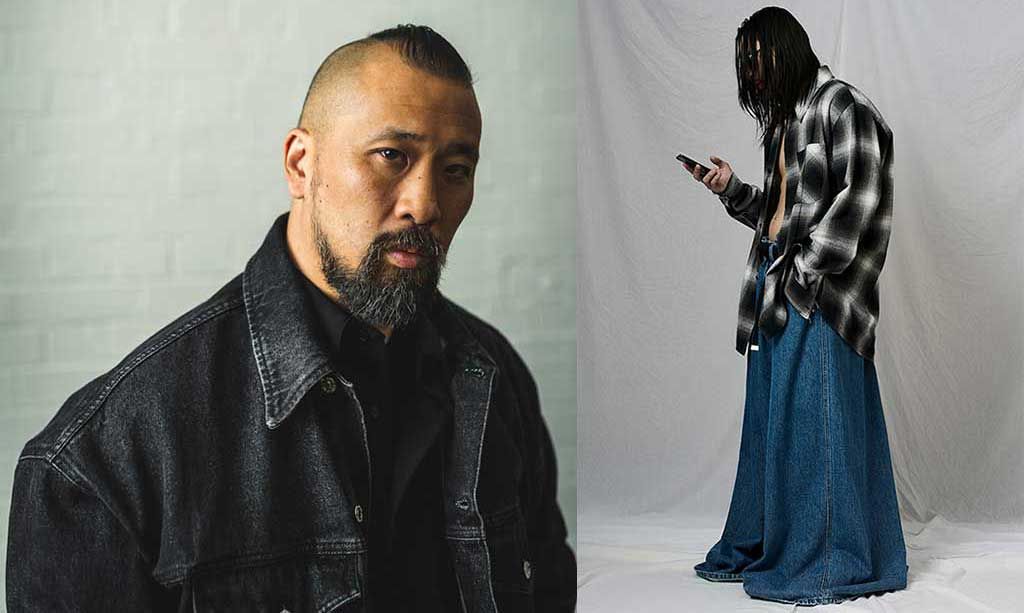
Left: Hung La, Photo: Stanley Morgan, Image via officemagazine.net; LỰU ĐẠN Men’s Fall 2023 Collection, Image via vogue.com
Hung La and LỰU ĐẠN
Vietnamese-American designer, Hung La, grew up in Maryland. with the struggle of navigating between two different cultures. He initially pursued a path in Computer Engineering in hopes of fulfilling his parents’ expectations, but he soon realized he needed to follow his own dreams.
La began to build a portfolio to study fashion design at Parsons School of Design, Istituto Marangoni, and continued at the Royal Academy in Antwerp where he completed his Master’s. After completing his education, he seized opportunities to work with esteemed creative directors Nicolas Ghesquière at Balenciaga, and Phoebe Philo at Céline.
As one of the very few Asian men at the studios, he experienced both acceptance and a sense of not belonging. During the COVID lockdown in 2020, he started his menswear brand LỰU ĐẠN, which translates to “grenade” or “dangerous man.” The brand carries a message of redefining Asian Masculinity and representation.
His Spring/Summer 2023 collection combines elements of Asian culture with 80s motorcycle gangs. He was inspired by the fashion found in Asian detective shows from the 80s that were remakes of their American counterparts. As someone who grew up without having many Asian role models, La aims to create a visual identity and attitude that empowers his community.
Recognizing the struggles faced by Asian creatives in the industry, he actively fosters community and connection. La feels that one of his greatest gifts has been the ability to connect with other Asian creatives who have shared similar struggles with their identity.
Through a blog series on his website called “City Tours,” he engages with Asian creatives around the world to share their stories in hopes of inspiring others to embrace their true selves, rather than feeling pressured to conform. He fosters a sense of belonging through his brand for those who, like him, have sought to see themselves clearly in a world that sometimes lacks inclusivity.
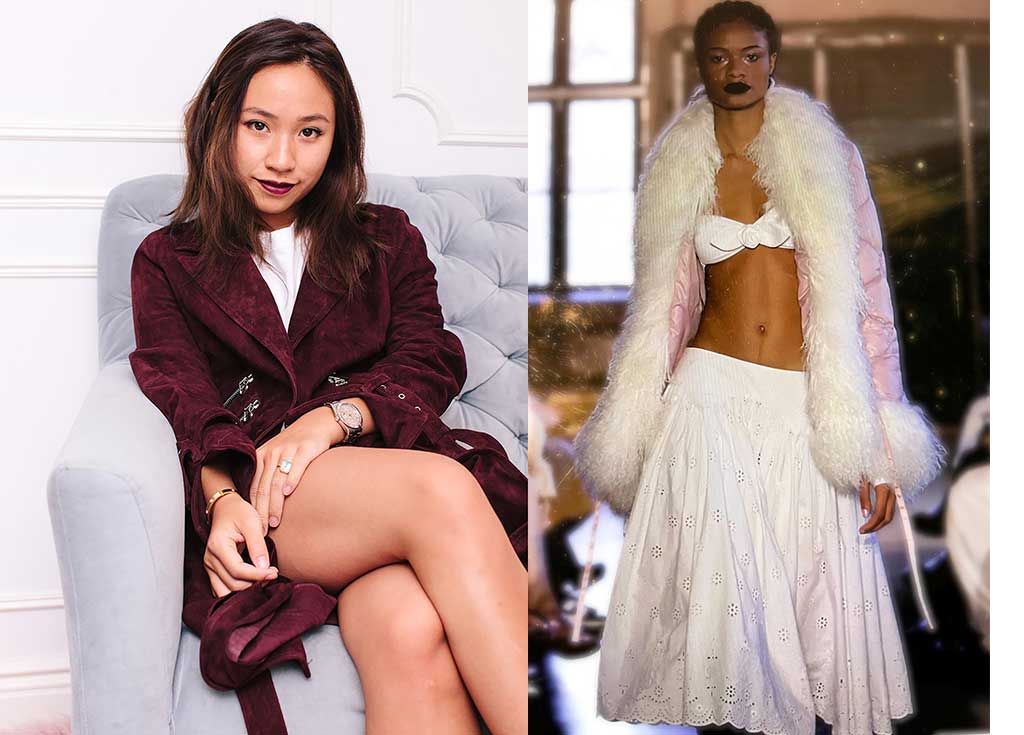
Left: Sandy Liang, Photo: Atisha Paulson, Image via refinery29.com; Right: Sandy Liang Resort 2022 Collection, Image via sandyliang.info
Sandy Liang and Sandy Liang
Sandy Liang, New York City fashion designer, began her eponymous label in 2014 after graduating from Parsons School of Design. Growing up, Liang’s family did not value clothing beyond functionality.
Her love for fashion was ignited by watching red carpet events on television inspiring her to draw garments she admired. Despite her initial plan to begin her career working for other companies, Liang felt that the timing was right, and with the support from her family she was able to obtain the funds to launch her brand. Her friends and family served as models for her first designs.
She attended fabric appointments on her own and relied on social media and email to reach out to potential buyers. Liang achieved early success when her fleece jacket design became a sensation at New York Fashion Week in 2019, earning recognition from the New York Times.
Liang infuses her designs with personal and cultural elements. Her Chinese grandmother’s bold and carefree style left a lasting impression on her. To honor her heritage, Liang featured her grandmother as the model in her first lookbook.
Her childhood memories, including playing with toys like Polly Pockets, became the inspiration behind her Resort 2022 collection as she wanted to evoke a sense of nostalgia through her pieces. Her daily experiences, including street wear and uniforms that people wore to work – spark her creativity.
Today, Liang is renowned for her “Downtown New York” aesthetic and her modern approach to incorporating Asian culture into fashion. For instance, her collaboration with footwear brand, Salomon, featured anime graphics. Liang’s connection to her upbringing and heritage not only sets her designs apart, but also helps to promote inclusivity. Her cultural fusion approach to design emphasizes that fashion can serve as a bridge for different backgrounds.
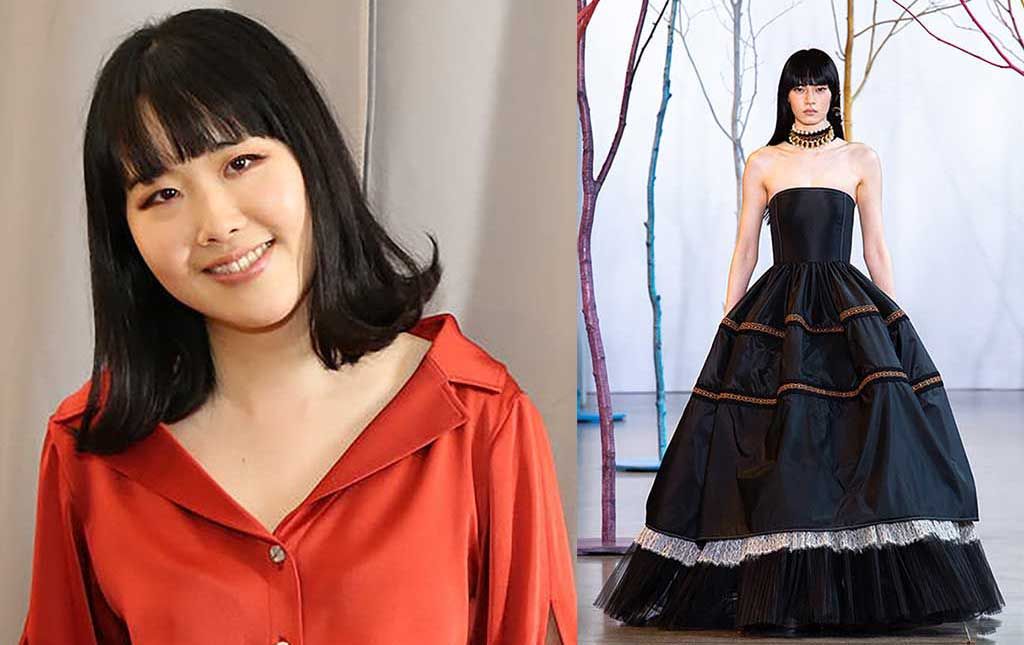
Left: Hanako Maeda, Photo: Rachel Akinasi; Image via businessinsider.com; Right: Fall/Winter 2019, Photo: Filippo Fior/GoRunway, Image via fashionweekdaily.com
Hanako Maeda and Adeam
Hanako Maeda, designer behind the brand Adeam, hails from Tokyo, Japan. She graduated with an Art History degree from Columbia University in 2010, and immediately moved back to Japan to work for her parents’ fashion label, “FOXEY.”
In 2012, she launched her own brand, Adeam, based in New York. Maeda crafts her designs for the modern women’s wardrobe. She seamlessly blends the essence of “East meets West” through her use of traditional Japanese techniques onto contemporary silhouettes.
For instance, her Fall/Winter 2016 collection was inspired by Boro Patchwork, which is an 18th century Japanese art form of mending and patching fabrics. She also explored Kumihimo weaving, a traditional braiding technique that was once used for samurai armor lacing, which she incorporated into denim pieces.
Maeda aims to make women’s lives easier by designing functional clothes. Many of her pieces are machine washable, wrinkle-free, or water-resistant, emphasizing practicality without having to sacrifice style.
Her brand has garnered a strong celebrity following and is a platform for Maeda to express and celebrate her Japanese background. This can be seen in her collaboration with Japanese tennis player Naomi Osaka, where she uses traditional Japanese elements like origami draping and architectural seams, and mixes them with modern styles including ruffled lace and soft, feminine knits.
By selecting high quality fabrics that feel luxurious against the women silhouette, she prioritizes comfort and embraces femininity. Maeda empowers women by paying close attention to the fit and tailoring of her clothes which highlight individual beauty.
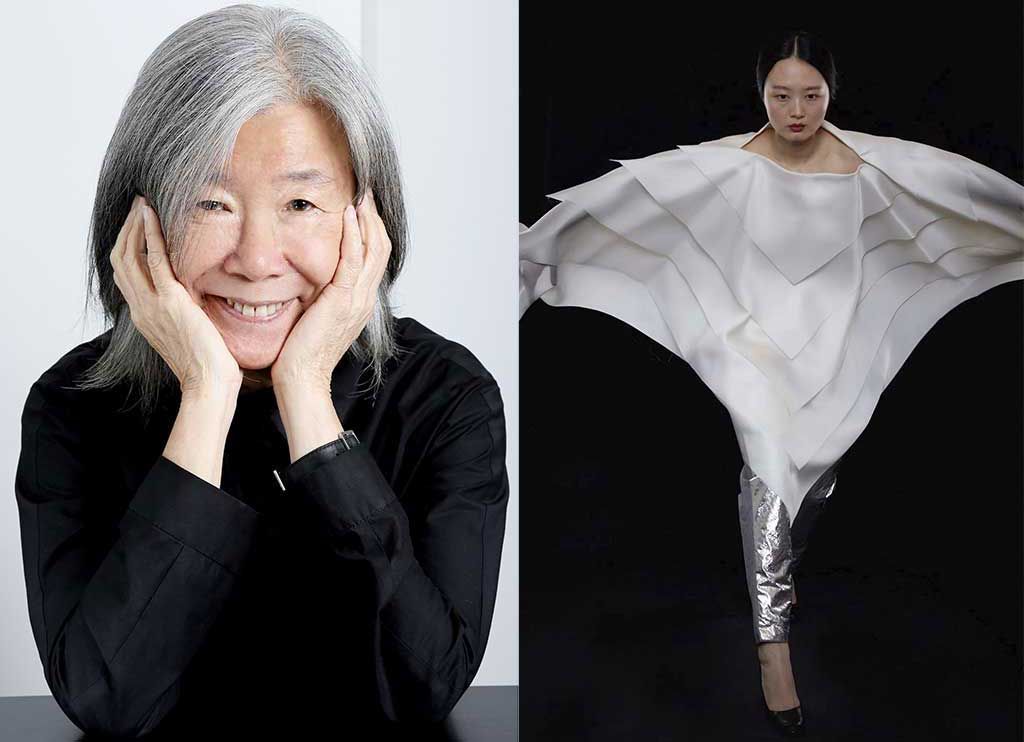
Left: Yeohlee Teng, Photo: Kyle Erickson, Image via efde.com; Right: YEOHLEE Spring 2022 Collection, Photo: Tom Concordia, Image via tokion.jp
Yeohlee Teng and YEOHLEE
Yeohlee Teng, born in Malaysia, early memories include following her mom around while purchasing fabrics and watching her making clothes. Teng followed this tradition and established herself as a patternmaker as a teen. Eventually her friends would ask her to make clothes for them.
Teng moved to the US to attend Parsons School of Design. She made her mark in New York City after establishing her eponymous brand in 1981. Fashion Index had the pleasure of interviewing Teng, and we gained further insight into her life and journey as a designer.
Since YEOHLEE’s beginning, Teng’s tenet of sustainability has embodied a powerful message through her creations. Guided by her zero-waste philosophy, she makes sure that no scraps or fabric go unused. Coming from a small island, Teng understands and appreciates the finite nature of resources. “Don’t waste fabric, but truly don’t waste time. It’s not a fashion philosophy, it’s a way of life,” she told us.
Her designs offer a seamless interpretation where there are no distinct boundaries between different cultures. She believes that clothing should have a universal appeal, making her particularly fond of Malaysian menswear and how it is often worn by both men and women. Teng said she “can be inspired by life, the universe and everything” for her designs. It may be the quality of light in a space, or the particular fabric she is working with.
Her first successful design was a zero-waste cape. A version of this cape has been in every collection since 1981. Her cape silhouette is still selling after more than 40 years. Teng believes her cape belongs in the “lexicon of fashion.”
Additionally her work is described as architectural in nature and has gained attention of critics and professionals from other fields. Issey Miyake said her 1982 exhibit at MIT “proves that fashion no longer has to be separated from the other design fields.” Throughout her illustrious career, Teng has pushed for responsible fashion practices.
She champions mindful consumption and sustainable production by not only factoring aesthetics in her designs, but also the elements of time, energy, and material. Her zero-waste approach yields multi-faceted creations that are suitable for various occasions and meant to be cherished for a long time. Taking her commitment to environmental consciousness even further, Teng adopts a seasonless approach to each design, producing versatile pieces for year-round and lifelong wearability.
In the long-run, she aims to reduce the amount of clothes people buy and, therefore, discard. As Teng looks to the future of fashion she hopes there is an open dialog where one’s feelings and beliefs and core philosophies can be discussed and embraced.
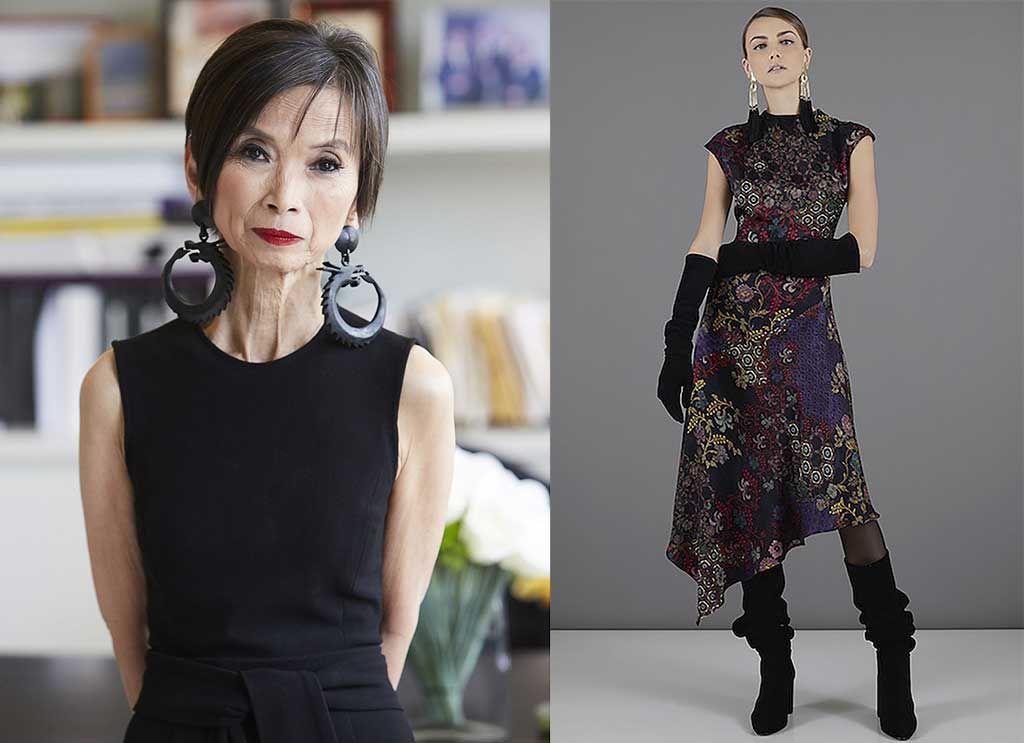
Left: Josie Natori, Photo: Masato Onoda/WWD, Image via wwd.com; Right: Natori Fall 2019 Collection, Image via boutique.humbleandrich.com
Josie Natori and The Natori Company
Filipino designer, Josie Natori, initially had no intentions of pursuing a fashion career. Her life took a turn when she impulsively took a finely embroidered blouse she received from a friend in the Philippines to a Bloomingdale’s buyer in New York City. The buyer suggested that she transform it into sleepwear.
At the age of 30, Natori left her secure job in Investment Banking to launch her brand in 1977. She felt she had accomplished everything she wanted in the finance world, and desired a new challenge. Natori saw an opportunity in finely crafted items from the Philippines, which she believed would find an audience in the United States.
Having no formal design training, she hired an independent designer to bring her ideas to life. Natori established a lingerie and clothing brand with designs that incorporated Asian materials like silk and piña, a traditional Philippine fabric made out of Pineapples.
In the early stages of her company, The Natori Company, Josie utilized her apartments in New York and Paris as showrooms, and would travel to the Philippines to personally oversee production. In 1979, after over a year of relying on family and friends to help trim and sew her designs, Natori’s father built her a factory in the Philippines that would allow her to better control quality and manage production.
The establishment brought jobs to over 500 people in the country, with about 90% of employees being women. The brand's commitment to showcasing the designs and craftsmanship of the Philippines earned Natori the prestigious Galleon Award in 1988, presented by Corazon Aquino, the president of the Philippines at the time. Through her innovative designs and reflecting the craftsmanship of the Philippines, she has created job opportunities and garnered recognition for the country on an international scale.
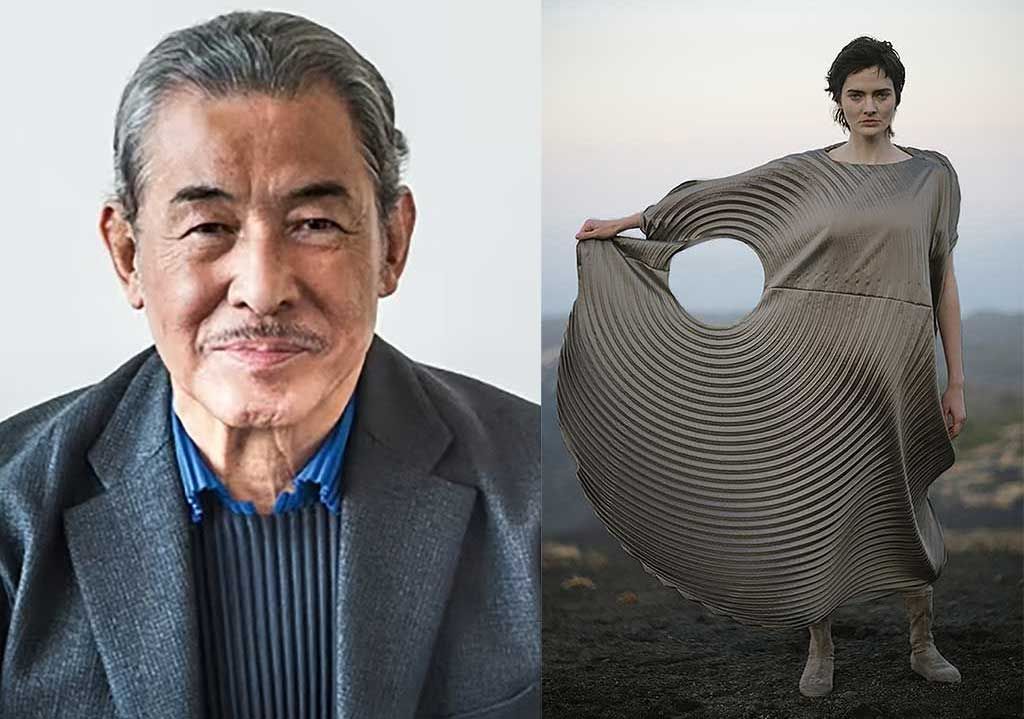
Left: Issey Miyake, Photo: Mark C O’Flaherty, Image via fashiongtonpost.com; Right: Issey Miyake Fall/Winter 2021 Collection, image via designscene.net
Issey Miyake and Miyake Design Studio
Issey Miyake was born in Hiroshima, Japan in 1938. After graduating from Tama Art University in Tokyo, he seized opportunities that would shape his career. Miyake first traveled to Paris in 1965, where he worked for esteemed fashion houses, Guy Laroche and Hubert de Givenchy. He then moved to New York in 1969 and found employment with designer Geoffrey Beene.
With these unique and varied experiences, Miyake returned to Tokyo in 1970 to establish the Miyake Design Studio. He revolutionized the concept of clothing as structural design rather than mere fashion.
This introduced a new perspective to explore the relationship between the body, the fabric that adorns it, and the space that emerges between these elements. He delved into research and experimentation with different techniques and created new forms of other techniques and technologies.
He developed a patented method of micro-pleating involving heat-treating already-assembled clothing that first gained notoriety in the 1980’s. This process allows garments to be permanently pleated, resulting in a unique and sculptural design.
Pleating machines developed by several engineers from the Internal Pleats Laboratory within the Miyake Design Studio are now used to create his signature technique. His infamous twist-top designs implemented the twisting of fabric that was then heated so that the wrinkles were baked into them, adding further texture to his creations.
Miyake embraced functional yet overlooked arts and sought to revitalize these methods, like Sashiko embroidery, a traditional Japanese stitching method used to create a patterned background. His work in fabric manipulation and construction methods serve as inspiration for future designers to think outside the box.
The Miyake Foundation was founded in 2004 to cultivate design evolution in society and spread knowledge to future generations through professional training and collaboration. Sadly, Miyake passed away in 2022, but has left behind a profound and enduring impact on the fashion community and beyond.
AAPI Designers Enhance The Fashion Industry
Asian American and Pacific Islander designers have contributed much to the fashion world, promoting inclusivity and advocating for and designing with more conscientious practices in the industry. Breaking into an industry dominated by European and American brands, early AAPI designers helped to create opportunities and establish representation.
Today, a new generation of AAPI designers continue to proudly represent their heritage and introduce fresh perspectives to fashion. They bring diversity and empowerment to the industry, creating a more welcoming space for all, especially other AAPI individuals.
Through collaborations and partnerships, they have introduced their culture to a wider audience and opened doors for future designers to thrive, ensuring that the next generation is equipped to make a lasting impact. As we honor Asian American Pacific Islander Heritage Month, we recognize the influential AAPI designers who have laid the foundation in a continuously evolving landscape for current AAPI designers to shape.